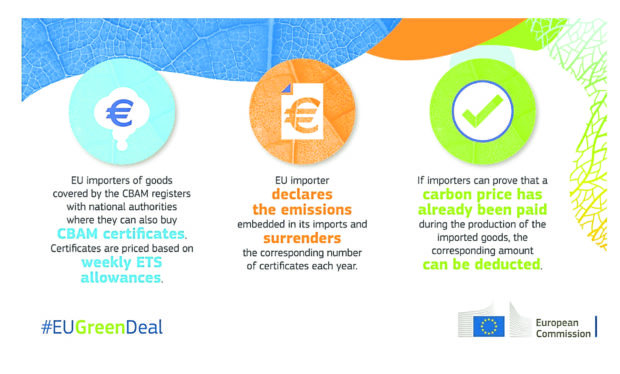
HOW CBM WORKS The Carbon Border Adjustment Mechanism aims to put a fair price on the carbon footprint of goods exported to EU–From the website of EU Taxation and Customs Union.
The Philippine export industry is preparing for the implementation of a new regulation of the European Union (EU) that will account for carbon usage in traded goods, a measure that entails additional reporting and friction cost for goods flowing to countries under the regional bloc.
The Philippine Exporters Confederation (Philexport) told the Inquirer that they have informed their members about the EU’s carbon border adjustment mechanism (CBAM), but expressed concern that smaller exporting companies may find it more difficult due to costs associated with the measure.
“We have shared the information with our members to help them prepare,” said Philexport vice president for advocacy, communications and special Concerns Ma. Flordeliza Cusi Leong when sought for comment, adding that a webinar was conducted to keep their members apprised of the developments.
“The challenge may be in the capacity, especially of MSMEs (micro, small and medium enterprises) if they will need to adjust production systems and adopt new technologies that may be costly,” she added.
Local companies that export to the EU, particularly iron and steel, aluminum, cement and fertilizers, were advised to prepare for the implementation of this new regulation.
The trade association said that Aaron Cosbey of the International Trade Centre had told them that a number of emission-intensive goods, including electricity, would be covered by the EU Commission’s proposal on the CBAM.
“CBAM is a border measure designed to make it such that foreign producers of certain goods face the same carbon costs that are faced by EU producers,” said the official from the joint agency of the World Trade Organization (WTO) and the United Nations, as quoted by the trade group.
Making producers accountable
Under the CBAM, Cosbey said that producers must register their operations in an EU-maintained central database and provide basic information. They must also commission an accredited verifier to assess the greenhouse gas emission of local exporting firms.
“Submitting the resulting data is technically the importer’s responsibility, but in practice, importers will demand this data from producers,” said Cosbey.
On the other hand, importers, which are called declarants, have to apply for an authorization to import CBAM-covered goods before importing.
According to the EU Commission, the CBAM is meant to put a fair price on the carbon emitted during the production of carbon intensive goods that are entering the EU, as well as to encourage cleaner industrial production in non-EU countries.
“By confirming that a price has been paid for the embedded carbon emissions generated in the production of certain goods imported into the EU, the CBAM will ensure the carbon price of imports is equivalent to the carbon price of domestic production, and that the EU’s climate objectives are not undermined,” said the EU Commission.
The commission said the CBAM would initially apply to imports of certain goods whose production was deemed as carbon-intensive and at most significant risk of carbon leakage. These include cement, iron and steel, aluminum, fertilizers, electricity and hydrogen.
The EU Commission said that once the permanent system enters into force in January 2026, importers will need to declare the greenhouse gas emission involved in the production of goods entering member countries. They will then surrender the corresponding number of CBAM certificates, which comes at a price that is dependent on the weekly average auction price of EU Emission Trading System allowances.
By economic bloc, the EU is the Philippines’ fourth largest export market in 2020 and 2021, according to the Philippine Statistics Authority, accounting for 10 percent of the total. In 2021, the Philippines exported $853.45 billion worth of goods to the EU, growing by 22.8 percent from $695.02 billion in 2020